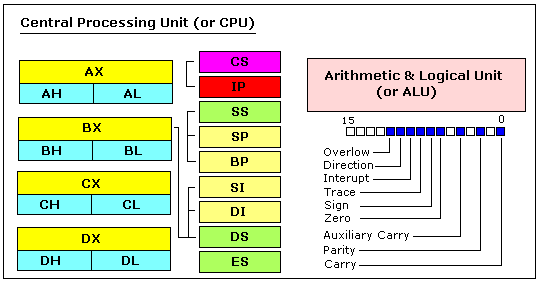This tutorial is intended for those who are not familiar with assembler at all, or have a very distant idea about it. Of course if you have knowledge of some other programming language (Basic, C/C++, Pascal...) that may help you a lot.
But even if you are familiar with assembler, it is still a good idea to look through this document in order to study emu8086 syntax.
It is assumed that you have some knowledge about number representation (HEX/BIN), if not it is highly recommended to study Numbering Systems Tutorial before you proceed.
What is an assembly language?
Assembly language is a low level programming language. You need to get some knowledge about computer structure in order to understand anything. The simple computer model as I see it:

The system bus (shown in yellow) connects the various components of a computer.
The CPU is the heart of the computer, most of computations occur inside the CPU.
RAM is a place to where the programs are loaded in order to be executed.
Inside the CPU

GENERAL PURPOSE REGISTERS
8086 CPU has 8 general purpose registers, each register has its own name:
- AX - the accumulator register (divided into AH / AL).
- BX - the base address register (divided into BH / BL).
- CX - the count register (divided into CH / CL).
- DX - the data register (divided into DH / DL).
- SI - source index register.
- DI - destination index register.
- BP - base pointer.
- SP - stack pointer.
Despite the name of a register, it's the programmer who determines the usage for each general purpose register. The main purpose of a register is to keep a number (variable). The size of the above registers is 16 bit, it's something like: 0011000000111001b (in binary form), or 12345 in decimal (human) form.
4 general purpose registers (AX, BX, CX, DX) are made of two separate 8 bit registers, for example if AX= 0011000000111001b, then AH=00110000b and AL=00111001b. Therefore, when you modify any of the 8 bit registers 16 bit register is also updated, and vice-versa. The same is for other 3 registers, "H" is for high and "L" is for low part.
Because registers are located inside the CPU, they are much faster than memory. Accessing a memory location requires the use of a system bus, so it takes much longer. Accessing data in a register usually takes no time. Therefore, you should try to keep variables in the registers. Register sets are very small and most registers have special purposes which limit their use as variables, but they are still an excellent place to store temporary data of calculations.
SEGMENT REGISTERS
- CS - points at the segment containing the current program.
- DS - generally points at segment where variables are defined.
- ES - extra segment register, it's up to a coder to define its usage.
- SS - points at the segment containing the stack.
Segment registers work together with general purpose register to access any memory value. For example if we would like to access memory at the physical address 12345h (hexadecimal), we should set the DS = 1230h and SI = 0045h. This is good, since this way we can access much more memory than with a single register that is limited to 16 bit values.
CPU makes a calculation of physical address by multiplying the segment register by 10h and adding general purpose register to it

The address formed with 2 registers is called an effective address.
By default BX, SI and DI registers work with DS segment register;
BP and SP work with SS segment register.
Other general purpose registers cannot form an effective address!
Also, although BX can form an effective address, BH and BL cannot!
SPECIAL PURPOSE REGISTERS
- IP - the instruction pointer.
- Flags Register - determines the current state of the processor.
IP register always works together with CS segment register and it points to currently executing instruction.
Flags Register is modified automatically by CPU after mathematical operations, this allows to determine the type of the result, and to determine conditions to transfer control to other parts of the program.
Generally you cannot access these registers directly.